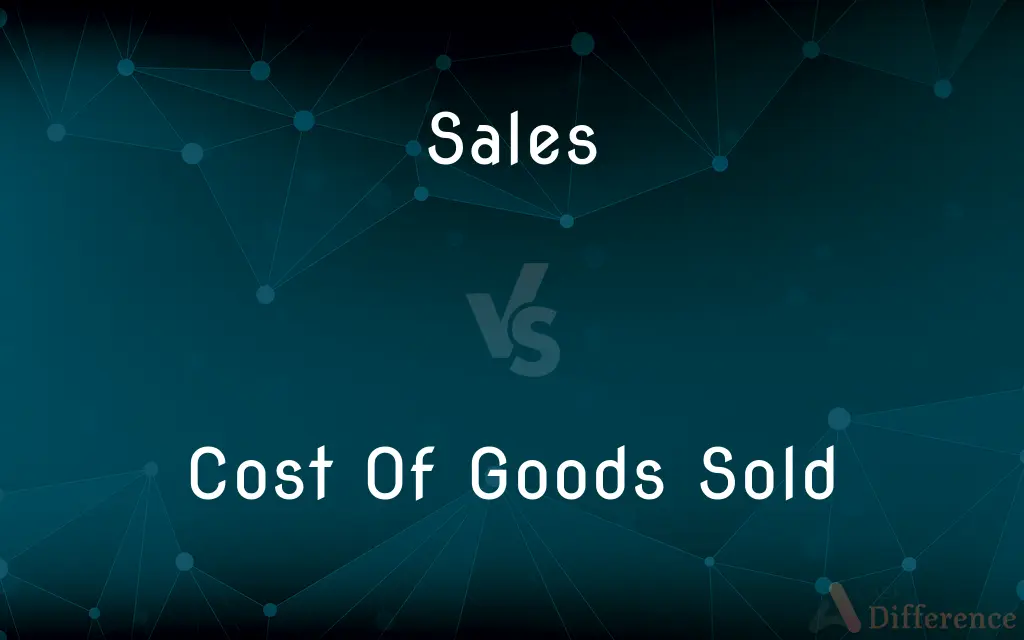Sales vs. Cost Of Goods Sold — What's the Difference?
By Tayyaba Rehman — Published on October 2, 2023
Sales are the revenue generated from selling goods or services, while Cost of Goods Sold (COGS) represents the direct costs incurred in producing those sold goods or services.

Difference Between Sales and Cost Of Goods Sold
Table of Contents
ADVERTISEMENT
Key Differences
Sales and Cost of Goods Sold (COGS) are critical components in determining a company’s profitability. Sales refer to the total revenue that a company generates from selling its goods or services. It is the starting point in a company’s income statement and reflects the value that customers are willing to pay for the company’s offerings. Understanding and optimizing sales is crucial for businesses aiming to achieve growth and success.
In contrast, Cost of Goods Sold represents the direct costs associated with the production or acquisition of the goods or services sold by the company. These can include material costs, labor costs, and manufacturing overhead. COGS is deducted from Sales to calculate Gross Profit, allowing a glimpse into the efficiency and effectiveness of production and pricing strategies.
The relationship between Sales and Cost of Goods Sold is significant in evaluating a company’s financial health. If Sales exceed COGS, the company has a gross profit, indicating effective production and pricing. On the other hand, if COGS are higher than Sales, it results in a gross loss, reflecting inefficiencies and necessitating strategic adjustments.
Management of both Sales and Cost of Goods Sold is fundamental for achieving sustainable profitability. Analyzing Sales provides insights into market demand, customer preferences, and pricing elasticity, while understanding COGS enables the optimization of production costs and resource allocation. Balancing the two ensures that companies can generate adequate profits while maintaining competitive pricing and quality.
Comparison Chart
Definition
Total revenue from selling goods or services.
Direct costs incurred in producing or acquiring sold goods.
ADVERTISEMENT
Impact on Profitability
Increases profitability.
Reduces profitability.
Representation
Top line of the income statement.
Deducted from sales to calculate gross profit.
Management Focus
Optimizing revenue through pricing strategies and customer reach.
Managing and reducing production and acquisition costs.
Calculation
Quantity sold multiplied by selling price.
Sum of direct costs like material, labor, and manufacturing overhead.
Compare with Definitions
Sales
Sales are the total revenue generated from selling goods or services.
The company reported increased sales in the last quarter, signaling growing demand.
Cost Of Goods Sold
Cost of Goods Sold impacts a company’s profitability and pricing strategies.
Reducing Cost of Goods Sold allowed the company to offer competitive pricing without compromising on profitability.
Sales
Sales provide insights into market demand and customer preferences.
Analyzing sales trends helped the company tailor its products to consumer needs.
Cost Of Goods Sold
Cost of Goods Sold is the total of direct costs related to the production of goods.
The company’s Cost of Goods Sold increased due to rising raw material prices.
Sales
Sales are represented as the top line on the income statement.
A rise in sales positively impacted the company’s overall financial performance.
Cost Of Goods Sold
Cost of Goods Sold includes material, labor, and overhead costs.
A detailed analysis of Cost of Goods Sold can highlight areas for cost reduction and efficiency improvement.
Sales
Sales reflect the value customers pay for products or services.
Higher sales indicated successful marketing and a favorable market response.
Cost Of Goods Sold
Cost of Goods Sold provides insights into production efficiency and cost management.
By optimizing Cost of Goods Sold, the company can improve its production processes and resource allocation.
Sales
Sales are crucial for business growth and profitability.
The team implemented several strategies to boost sales and expand market reach.
Cost Of Goods Sold
Cost of Goods Sold is subtracted from sales to calculate gross profit.
Managing Cost of Goods Sold effectively is crucial for maintaining healthy profit margins.
Sales
The exchange of goods or services for an amount of money or its equivalent; the act of selling
The sale of such a nice house should be easy.
Sales
A selling of property to the highest bidder; an auction.
Sales
An offer or arrangement in which goods are sold at a discount
The store has a sale on winter coats.
Sales
The business or activity of selling goods or services
She works in sales.
Sales
The number of items sold or the amount of money received for a number of items sold
Sales are better than expected.
Sales
Plural of sale
Sales
The activities involved in selling goods or services.
He's likable and motivated: perfect for a career in sales.
We have a sales training program beginning this Monday.
Sales
The amount or value of goods and services sold.
Sales were up 12% over last year.
Sales
Income (at invoice values) received for goods and services over some given period of time
Common Curiosities
Is Cost of Goods Sold related to production costs?
Yes, Cost of Goods Sold includes all the direct costs related to the production or acquisition of goods.
Do higher Sales always lead to higher profits?
Not necessarily, as profits also depend on the control of costs, including Cost of Goods Sold.
What do Sales represent in a company’s finances?
Sales represent the total revenue generated from selling goods or services.
How does managing Cost of Goods Sold affect profitability?
Effectively managing Cost of Goods Sold can lead to improved profit margins by optimizing production and acquisition costs.
Is Sales the same as Profit?
No, Sales is total revenue, while Profit is what remains after subtracting all costs, including Cost of Goods Sold, from Sales.
Share Your Discovery

Previous Comparison
CAST vs. CONVERT
Next Comparison
Attract vs. DrawAuthor Spotlight
Written by
Tayyaba RehmanTayyaba Rehman is a distinguished writer, currently serving as a primary contributor to askdifference.com. As a researcher in semantics and etymology, Tayyaba's passion for the complexity of languages and their distinctions has found a perfect home on the platform. Tayyaba delves into the intricacies of language, distinguishing between commonly confused words and phrases, thereby providing clarity for readers worldwide.
















































